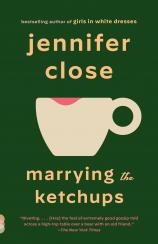Marrying the Ketchups
Review
Marrying the Ketchups
In his 1933 short story, “A Clean, Well-Lighted Place,” Ernest Hemingway wrote fondly of a favorite café --- that special place to go, a place where they have to take you in, even when you’re at your lowest.
In Jennifer Close’s MARRYING THE KETCHUPS, JP Sullivan’s, a restaurant in Oak Park, Illinois, is just that place for all of her characters. It’s where they gather, regroup, seek solace, celebrate and have a good meal. The story opens in October 2016, with the family patriarch, Bud Sullivan, watching his beloved underdogs, the Chicago Cubs, win and assure their place in that year’s World Series. It was a time of both incredible feats and much anxiety, with the upcoming presidential election dividing friends and families alike. After watching the Cubs win, Bud dies 23 minutes later.
Bud and his adoring wife, Rose, opened JP Sullivan’s in 1979, offering such rib-sticking meals as homemade meatloaf and the best burgers around. Usually, one or more members of the family worked there, and as per Bud’s example, they did not receive preferential treatment: “It was tricky to work at Sullivan’s and be a Sullivan. You were part of the staff and also you weren’t. You didn’t want to seem snobby, but you (obviously) couldn’t hang out with everyone and bitch about management. You worked hard so that you didn’t seem lazy. You took breaks so you didn’t seem too eager. You smiled a lot.” It became not only the most popular restaurant in the area, but also the official hub of the Sullivan clan.
"MARRYING THE KETCHUPS deftly handles the subjects of family, politics and family politics in a charming and relatable way."
After losing the love of her life, poor Rose finds day-to-day living a struggle. Her adult children, Charlie and Gail, decide that the best plan for her is to move into a very active and social retirement community, which unfortunately she dislikes. She just wants to go home. Gail’s son, Teddy, in the wake of a devastating breakup with his boyfriend, gives up his job at a trendy bar downtown to return to work at Sullivan’s, along with his Uncle Charlie and his half-sister, Riley (a late addition to the family, courtesy of Gail’s husband’s affair). Teddy loves his family, but sometimes they can be a lot: “Teddy’s problem was that once his family gave their opinions, he could no longer remember his own. Things got blurry. All he wanted --- all he ever wanted --- was to please them.”
Charlie’s two daughters, Jane and Gretchen, are also going through major life upheavals. Jane and her husband, Mike, had left Oak Park years before in favor of the suburb of Lake Forest, where she found herself “placed in a book club and a bunco group. She didn’t ask to join either.” It was for a better life for their daughter, Lauren, but Jane has found it hard to fit in among the perfect yoga mommies. While in a marriage counseling session, Mike announces that he thinks they should separate. This is not where Jane envisioned herself and her life in her mid-30s. She envies Rose and her life in the retirement village, “jealous of the way that Rose misses Bud, of how extreme her grief is.” She can’t imagine ever missing Mike like that.
Gretchen is also facing a sea change. After years of living in New York City, performing in a ’90s cover band, her boyfriend and bandmate, Billy, announces he’s been having an affair with Nancy, their other friend and bandmate. Even when dealing with relatable and sometimes dire events, Close peppers in the perfect amount of Irish humor in her characters and situations. Upon realizing that their dinner was actually a break-up dinner, “She [Gretchen] was immediately disappointed because she’d been looking forward to ordering the steak frites, and now she’d have to leave before she could eat.”
Gretchen leaves New York, returning to Chicago and the safe harbor of Sullivan’s. She knew she could regroup there. Some might call it avoidance, but she calls it comfort. She returns to work in the restaurant, along with Teddy, Riley and Charlie, and finds it rewarding while she’s figuring out her next move: “Her body was tired in a satisfying way and she knew she would sleep well for the first time in months. This was what she always appreciated about working in a restaurant, how it consumed and exhausted you, how the tasks were clear and finite. It was satisfying to complete each assignment, like getting a gold star for a job well done. At the end of the night, you had enough to fill the sky.”
MARRYING THE KETCHUPS deftly handles the subjects of family, politics and family politics in a charming and relatable way. Anyone who has ever worked in a restaurant will immediately understand the title (when you're a server, you do what is referred to as “side-work,” either at the beginning or end of a shift, where part of your duties include combining the half-used ketchups into one, hence “marrying” them.) Each member of the Sullivan clan returns to the family restaurant to find comfort and support as they fill themselves up again.
Fans of Close’s previous books, GIRLS IN WHITE DRESSES and THE HOPEFULS, as well as novels like Jonathan Tropper’s THIS IS WHERE I LEAVE YOU, will enjoy this family chronicle of life’s ups and downs, which are made all the better when the burdens are shared with loved ones.
Reviewed by Bronwyn Miller on April 29, 2022




